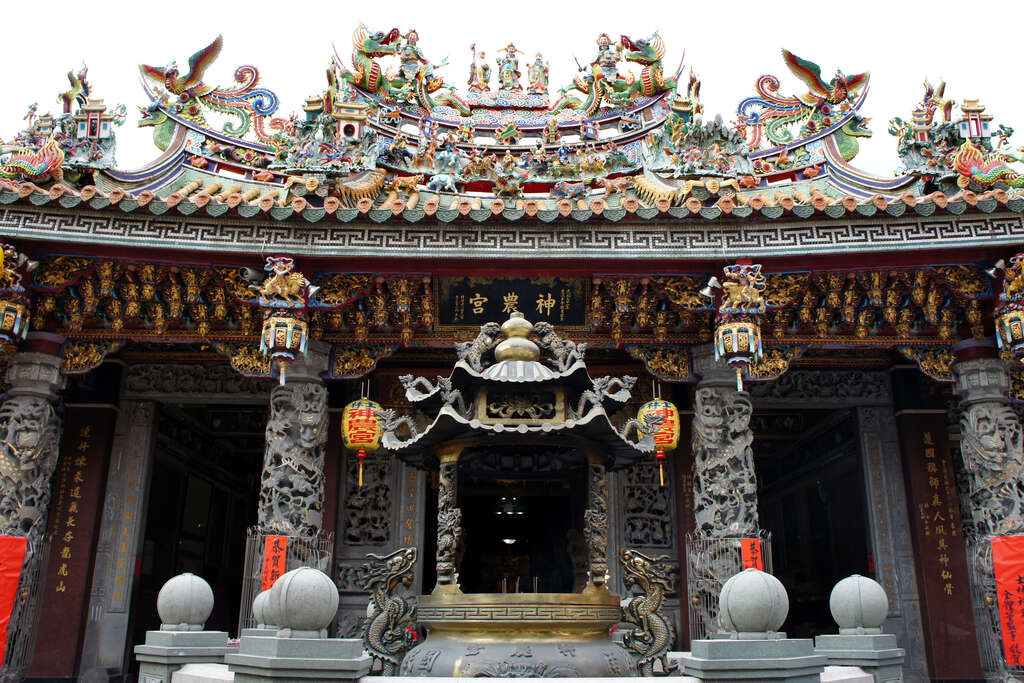Shilin Shen Nong Temple Introduction
Today, the architecture of Shilin Shen Nong Temple consists of a two-entry and five-bay layout. Above the left and right side rooms of the San Chuan Hall, there are also bell and drum towers. The main hall of the temple has two floors, with the deity Shen Nong Da Di enshrined in the center of the second floor, while the Fortune and Earth God (Fu De Zheng Shen) is honored in the center of the first floor. In addition to the three doors of the San Chuan Hall at the front of Shen Nong Temple, there is also one door each in front of the left and right side rooms. As Shen Nong Da Di is a deity of imperial status, the main façade of the temple can open more than five doors to showcase the deity's noble status. In ancient China's imperial era, the court mandated that the architectural form of temples must correspond with the rank of the deities being worshiped. Shilin Shen Nong Temple was originally named "Zhi Lan Temple," dedicated to the worship of the Earth God. However, during the Qianlong era, when local residents repaired the temple for the Fortune and Earth God, they adopted a style of roof with curved eaves only allowed for deities of imperial rank, highlighting the important status of the Earth God in the hearts of immigrants, but making the temple overly ornate and non-compliant with regulations. To avoid demolition penalties for the temple's non-compliance, local residents added the worship of Shen Nong Da Di, a deity of imperial rank, as the primary god. This transformation reflects a compromise and integration between Han Chinese temple and family ceremonial orders and local beliefs. Shilin Shen Nong Temple has undergone multiple renovations, yet still retains many old artifacts, such as the stone-carved dragon pillars in front of the San Chuan Hall and the stone beams and stone-carved windows in the temple. The longevity and prosperity tablets from the Qianlong era and incense burners from the Xianfeng era can be found, along with stone statues of Shen Nong Da Di and Fu De Zheng Shen carved during the Qing Dynasty. The columns on both sides of the main hall contain stone pillars from the Japanese colonial period, and the design of the main hall walls has been maintained from that period, using Guanyin Mountain stone that showcases characteristics of its time, which is difficult to replicate today. The temple also preserves several stone tablets documenting the history of temple repairs and lists of donations, as well as the respectful letter-burning pavilion used by people, witnessing the development process of the Shilin area and the historical flourishing of culture in its early years. Inside the Shen Nong Temple, multiple statues of Shen Nong Da Di are enshrined. The statue of Shen Nong Da Di typically comes in two forms: one depicting a naked, barefoot figure who is adorned only with leaves around the shoulders and waist, holding a golden sheaf of rice, symbolizing the invention of agriculture and the transition from primitive to civilization; the other wearing royal attire and a crown, symbolizing the esteemed status of Huaxia civilization and founding ancestors. The Shen Nong Da Di worshiped at Shilin Shen Nong Temple is portrayed in the primitive form and has both red and black faces. The red face symbolizes Shen Nong's rosy complexion after cultivating crops, while the black face commemorates the sacrifice of Shen Nong for tasting poisonous herbs, highlighting his search for medicinal plants for the people. On the other hand, there are many high-temperature colored glazed "Jiao Zhi" pottery works in the temple, created by Chen Zhuan You (1911 - ), a disciple of Hong Kun Fu, recognized as one of the "Five Tiger Generals" in mid-20th century Taiwanese temple architectural decoration skills. Decorations in Taiwanese temples featuring Jiao Zhi pottery often use themes from traditional drama, and a thematic story presented on a wall is referred to as a "Zhu Tou." In the horizontal beam of the inner hall of the San Chuan Hall, there are six Jiao Zhi pottery Zhu Tou, along with the "Water Wheel Block" near the eaves on the front hall wall, as well as the "Opposite Viewing Block" on the two opposing side walls, making a total of twelve Jiao Zhi pottery Zhu Tou, with over seven figures in each block, showcasing a considerable total number of figures, displaying delicate postures and preserving rich traditional decorative craftsmanship.

























